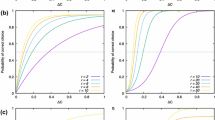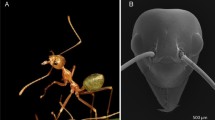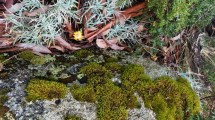Summary
The colour vision of worker antsCataglyphis bicolor was investigated by means of a colour mixture apparatus (Fig. 1). In freely walking ants the spontaneous phototactic choice behaviour as well as the choice behaviour after previous training to monochromatic or white light stimuli were tested in the spectral range 320≦λ≦ 627 nm. For all wavelengths standard intensities (I 0.5) were used that caused equal attractiveness and thus exhibited equal subjective brightness for the ants.
-
1.
The spectral sensitivity function of the spontaneous phototactic choice behaviour is characterised by four peaks (λ max=342, 425, 505, and 570 nm). The relative heights of the peaks are about 5.5∶1.0∶1.0∶0.5, respectively (Fig. 5).
-
2.
The visual system of the ant can selectively be adapted to all four ranges which the ant is maximally sensitive to (Fig. 6). The difference spectrum in Fig. 7 shows the spectral sensitivity curve of the postulated long-wavelength receptor type (λ max=570 nm).
-
3.
A wavelength discrimination function was obtained by means of training experiments. It is characterised by three maxima (λ max=382, 449, and 550 nm). The accuracy of discrimination varies as follows: 382>449>550 nm (Fig. 8).
-
4.
Spectral lights ofλ max=342, 434, and 506 nm appear to the ants as maximally saturated hues. The yellow range seems to be moderately saturated (Fig. 9).
-
5.
Colour mixture experiments show that the hue continuously varies along the wavelength scale and that the spectral range which the ant is sensitive to is closed via the ant-purple range (Fig. 10).
-
6.
All 16 tested monochromatic lights and antpurple are distinctly discriminated from a white light stimulus, i.e. a “white instance” also exists in the ant's colour vision system.
-
7.
Four pairs of complementary colours were tested, including ant-purple. Complementary colours are the wavelengths 342 and 504, 434 and 574, 382 and 550, 351/574 and 449 nm when presented by the relative intensities 0.37 to 0.63, 0.32 to 0.68, 0.25 to 0.75, and 0.25/0.25 to 0.50, respectively (Fig. 13).
-
8.
The hypothesis of a tetrachromatic colour vision system in the antCataglyphis bicolor is tentatively discussed. Four spectral types of receptors are postulated (R345, R430, r505 and r570) and different possibilities of how to build a yellow receptor (R570) are considered. A hypothetical chromaticity diagram is proposed (Fig. 17).
Similar content being viewed by others
References
Arnett, D.W.: Spatial and temporal integration properties of units in the first optic ganglion of dipterans. J. Neurophysiol.35, 429–444 (1972)
Autrum, H.: Die spektrale Empfindlichkeit der Augenmutation white-apricot vonCalliphora erythrocephala. Biol. Zbl.74, 515–524 (1955)
Autrum, H., Thomas, I.: Comparative physiology of colour vision in animals. In: Handbook of sensory physiology, Vol. VII/3A. Jung, R. (ed.), pp. 661–692. Berlin, Heidelberg, New York: Springer 1973
Autrum, H., Zwehl, V. von: Die spektrale Empfindlichkeit einzelner Sehzellen des Bienenauges. Z. Vergl. Physiol.48, 357–384 (1964)
Bruckmoser, P.: Die spektrale Empfindlichkeit einzelner Sehzellen des RückenschwimmersNotonecta glauca L. (Heteroptera). Z. Vergl. Physiol.59, 187–204 (1968)
Burkhardt, D.: Spectral sensitivity and other response characteristics of single visual cells. Symp. Soc. Exp. Biol.16, 86–109 (1962)
Burkhardt, D.: Colour discrimination in insects. Adv. Insect Physiol.2, 131–173 (1964)
Carlson, S.D., Philipson, B.: Microspectrophotometry of the dioptric apparatus and compound rhabdom of the moth (Man-duca sexta) eye. J. Insect Physiol.18, 1721–1731 (1972)
Dartnall, H.J.A.: The interpretation of spectral sensitivity curves. Br. Med. Bull.9, 24–30 (1953)
Daumer, K.: Reizmetrische Untersuchungen des Farbensehens der Bienen. Z. Vergl. Physiol.38, 413–478 (1956)
Dörrscheidt-Käfer, M.: Die Empfindlichkeit einzelner Photorezeptoren im Komplexauge vonCalliphora erythrocephala L. J. Comp. Physiol.81, 309–340 (1972)
Eheim, W.P., Wehner, R.: Die Sehfelder der zentralen Ommatidien in den Appositionsaugen vonApis mellifica undCataglyphis bicolor (Apidae, Formicidae; Hymenoptera). Kybernetik10, 168–179 (1972)
Frisch, K. von: Demonstration von Versuchen zum Nachweis des Farbensinnes bei angeblich total farbenblinden Tieren. Verh. Dtsch. Zool. Ges.24, 50–58 (1914a)
Frisch, K. von: Der Farbensinn und Formensinn der Bienen. Zool. Jb. allg. Zool. Physiol.35, 1–182 (1914b)
Goldsmith, T.H.: Do flies have a red receptor? J. Gen. Physiol.49, 265–287 (1965)
Goldsmith, T.H.: The effects of screening pigments on the spectral sensitivity of some Crustacea with scotopic (superposition) eyes. Vision Res.18, 475–482 (1978)
Goldsmith, T.H., Bernard, G.D.: The visual system of insects. In: The physiology of insecta, Vol. II, Second edition, Rockstein. M. (ed.), pp. 165–272. New York, London: Academic Press 1974
Hamdorf, K.: Primärprozesse beim Sehen der Wirbellosen. Rhein. Westf. Akad. Wiss. N253, 1–42 (1975)
Hardie, R.C.: Electrophysiological properties of R7 and R8 in dipteran retina. Z. Naturforsch.32c, 887–889 (1977)
Heintz, E.: La question de la sensibilité des abeilles à l'ultraviolet. Insectes Sociaux6, 223–229 (1959)
Helversen, O. von: Zur spektralen Unterschiedsempfindlichkeit der Honigbiene. J. Comp. Physiol.80, 439–472 (1972)
Herrling, P.L.: Regional distribution of three ultrastructural re-tinula types in the retina ofCataglyphis bicolor FABR. (Formicidae, Hymenoptera). Cell Tiss. Res.169, 247–266 (1976)
Hertz, M.: New experiments on colour vision in bees. J. Exp. Biol.16, 1–8 (1939)
Hess, V. von: Experimentelle Untersuchungen über den angeblichen Farbensinn der Bienen. Zool. Jahrb.34, 81–106 (1913)
Järvilehto, M., Zeltler, F.: Localized intracellular potentials from pre- and postsynaptic components in the external plexiform layer of an insect retina. Z. Vergl. Physiol.75, 422–440 (1971)
Jameson, D., Hurvich, L.M.: Some quantitative aspects of an opponent-colors theory. I. Chromatic responses and spectral saturation. J. Opt. Soc. Am.45, 546–552 (1955)
Kaiser, W., Scidl, R., Vollmar, J.: The participation of all three colour receptors in the phototactic behaviour of fixed walking honeybees. J. Comp. Physiol.122, 27–44 (1977)
Kien, J., Menzel, R.: Chromatic properties of interneurons in the optic lobes of the bee. II. Narrow band and colour opponent neurons. J. Comp. Physiol.113, 35–53 (1977)
Kiepenheuer, J.: Farbunterscheidungsvermögen bei der roten WaldameiseFormica polyctena Förster. Z. Vergl. Physiol.57, 409–411 (1968)
Kirschfeld, K., Feiler, R., Franceschini, N.: A photostable pigment within the rhabdomere of fly photoreceptors no. 7. J. Comp. Physiol.125, 275–284 (1978)
Kirschfeld, K., Franceschini, N.: Ein Mechanismus zur Steuerung des Lichtflusses in den Rhabdomeren des Komplexauges vonMusca. Kybernetik6, 13–22 (1969)
Kolb, G., Autrum. H.: Selektive Adaptation und Pigmentwanderung in den Sehzellen des Bienenauges. J. Comp. Physiol.94, 1–6 (1974)
Kretz, R.: Verhaltensphysiologische Bestimmung der spektralen Empfindlichkeit beiCataglyphis bicolor FABR. (Formicidae, Hymenoptera). M.S. thesis. Universität Zürich (1973)
Kretz, R.: Verhaltensphysiologische Analyse des Farbensehens der AmeiseCataglyphis bicolor (Formicidae, Hymenoptera). Ph.D. thesis, Universität Zürich (1977)
Kühn, A.: Über den Farbensinn der Bienen. Z. Vergl. Physiol.5, 762–800 (1927)
Labhart, T.: Behavioral analysis of light intensity discrimination and spectral sensitivity in the honeybee,Apis mellifera. J. Comp. Physiol.95, 203–216 (1974)
Laughlin, S.B.: Receptor function in the apposition eye — an electrophysiological approach. In: Photoreceptor Optics. Snyder, A.W., Menzel, R., (eds), pp. 479–498. Berlin, Heidelberg, New York: Springer 1975
Laughlin, S.B.: Neural integration in the first optic neuropile of dragonflies. IV. Interneuron spectral sensitivity and contrast coding. J. Comp. Physiol.112, 199–211 (1976)
Lubbock, J.: Ameisen, Bienen und Wespen. Beobachtungen über die Lebensweise der geselligen Hymenopteren. Leipzig: F.A. Brockhaus 1883
Marak, G.E., Wolken, J.J.: An action spectrum for the fire ant (Solenopsis saevissima). Nature205, 1328–1329 (1965)
Marks, W.B.: Visual pigments of single goldfish cones. J. Physiol.178, 14–32 (1965)
Menzel, R.: Spectral sensitivity of monopolar cells in the bee lamina. J. Comp. Physiol.93, 337–346 (1974)
Menzel, R., Blakers, M.: Colour receptors in the bee eye — morphology and spectral sensitivity. J. Comp. Physiol.108, 11–33 (1976)
Menzel, R., Knaut, R.: Pigment movement during light and chromatic adaptation in the retinula cells ofFormica polyctena (Hymenoptera, Formicidae). J. Comp. Physiol.86, 125–138 (1973)
Menzel, R., Snyder, A.W.: Polarized light detection in the bee,Apis mellifera. J. Comp. Physiol.88, 247–270 (1974)
Meyer, E.P.: Strukturanalyse der Neurone I. und II. Ordnung im Sehsystem der AmeiseCataglyphis bicolor (Formicidae, Hymenoptera). Ph.D. thesis, Universität Zürich (1976)
Müller, H.: Versuche über die Farbenliebhaberei der Honigbiene. Kosmos12, 273–299 (1883)
Muntz, W.R.A.: Inert absorbing and reflecting pigments. In: Handbook of sensory physiology, Vol. VII/1. Dartnall, H.J.A. (ed.), pp. 529–565. Berlin, Heidelberg, New York: Springer 1972
Naka, K.I., Rushton, W.A.H.: S-potentials from colour units in the retina of fish (Cyprinidae). J. Physiol. (Lond.)185, 536–555 (1966)
Neumeyer, C.: Über den simultanen Farbkontrast der Honigbiene. Ph.D. thesis, Universität Freiburg i.Br. (1975)
Ribi, W.A.: The neurons of the first optic ganglion of the bee,Apis mellifera. Adv. Anat. Embryol. Cell Biol.50, 5–43 (1975)
Rodieck, R.W.: The vertebrate retina. Principles of structure and function. San Francisco: Freeman and Company 1973
Snyder, A.W., Menzel, R. (eds.): Photoreceptor optics. Berlin, Heidelberg, New York: Springer 1975
Snyder, A.W., Menzel. R., Laughlin, S.B.: Structure and function of the fused rhabdom. J. Comp. Physiol.87, 99–135 (1973)
Tsuneki, K.: On colour vision in two species of ants, with special emphasis on their relative sensitivity to various monochromatic lights. Jap. J. Zool.11, 187–221 (1953)
Wehner, R., Herrling, P.L., Brunnert, A., Klein, R.: Periphere Adaptation und zentralnervöse Umstimmung im optischen System vonCataglyphis bicolor (Formicidae, Hymenoptera). Rev. Suisse Zool.79, 197–228 (1972)
Wehner, R., Toggweiler. F.: Verhaltensphysiologischer Nachweis des Farbensehens beiCataglyphis bicolor (Formicidae, Hymenoptera). J. Comp. Physiol.77, 239–255 (1972)
Yager, D.: Behavioral measures and theoretical analysis of spectral sensitivity and spectral saturation in the goldfish,Carassius auratus. Vision Res.7, 707–727 (1967)
Yamashita, S., Tateda, H.: Spectral sensitivities of jumping spider eyes. J. Comp. Physiol.105, 29–41 (1976)
Author information
Authors and Affiliations
Additional information
Part of Ph.D. thesis performed under the leadership of Prof. Dr. R. Wehner, University of Zürich. Financially supported by grant nos. 3.814.72 and 3.529.75 of the Swiss National Science Foundation and partially by the G. and A. Claraz Foundation
I thank Dr. R. Wehner for his continuous interest in the work and for critically reading the manuscript, R. Sulzer for technical advice, and my wife Doris for help in the translation of the manuscript.
Rights and permissions
About this article
Cite this article
Kretz, R. A behavioural analysis of colour vision in the antCataglyphis bicolor (Formicidae, Hymenoptera). J. Comp. Physiol. 131, 217–233 (1979). https://doi.org/10.1007/BF00610430
Accepted:
Issue Date:
DOI: https://doi.org/10.1007/BF00610430




